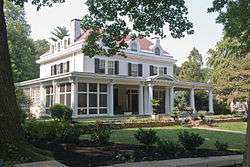Roland Park, Baltimore
|
Roland Park Historic District | |
 House along Goodwood Gardens | |
   | |
| Location | Irregular pattern between Belvedere Ave., Falls Rd., 39th St., and Stoney Run, Baltimore, Maryland |
|---|---|
| Coordinates | 39°20′57″N 76°38′05″W / 39.34917°N 76.63472°WCoordinates: 39°20′57″N 76°38′05″W / 39.34917°N 76.63472°W |
| Area | 700 acres (280 ha) |
| Built | 1890 |
| Architect | Olmsted, Frederick Law; Et al. |
| Architectural style | Late 19th And 20th Century Revivals, Late Victorian |
| NRHP Reference # | 74002213[1] |
| Added to NRHP | December 23, 1974 |
Roland Park is the first planned "suburban" community in North America, located in Baltimore, Maryland. It was developed between 1890 and 1920 as an upper-class streetcar suburb. The early phases of the neighborhood were designed by Edward Bouton and Frederick Law Olmsted, Jr.
History
Jarvis and Conklin, a Chicago investment firm, purchased 500 acres of land near Lake Roland in 1891 and founded the Roland Park Company with $1 million in capital. Not long after, the Panic of 1893 forced Jarvis and Conklin to sell the Roland Park Company to the firm of Stewart and Young. Despite the dire economics after 1893, Stewart and Young continued investment in the development.[2][3]
The Roland Park Company hired Kansas City developer Edward H. Bouton as the general manager and George Edward Kessler to lay out the lots for the first tract. They hired the Olmsted Brothers to lay out the second tract, and installed expensive infrastructure, including graded-streets, gutters, sidewalks, and constructed the Lake Roland Elevated Railroad. The company consulted George E Waring, Jr. to advise them on the installation of a sewer system. Bouton placed restrictive covenants on all lots in Roland Park. These included setback requirements and proscriptions against any business operations.[4]
Bouton and some Baltimore investors purchased the interests of Roland Park and reorganized the company in 1903.[5]
Frederick Law Olmsted, Jr. cited Roland Park as a model residential subdivision to his Harvard School of Design students. Duncan McDuffie, developer of St. Francis Wood in San Francisco, called Roland Park "an ideal residential district." Jesse Clyde Nichols had found inspiration in Roland Park when he was planning the Country Club District of Kansas City.[6] Nichols continued to refer to Roland Park as an ideal residential development when he counselled other residential developers.[7]
Roland Park Shopping Center

Roland Park Shopping Center is a single building strip of stores which opened in 1907 to serve the community, located at the corner of Upland Road and Roland Avenue. It has been credited by Guinness World Records as the world's first shopping center (though some editions of Guinness incorrectly date it to 1896). Since it had only six stores, despite it being an important milestone, larger shopping centers such as the Country Club Plaza (1923) in Kansas City, Missouri have received more attention as being "first," depending on what definition is used.[8][9][10]
Education
The neighborhood is within the bounds of Baltimore City Public Schools and is assigned to Roland Park Elementary/Middle School,[11] a K-8 school[12] that earned the Blue Ribbon for Academic Excellence from the state department of education.
There are several private schools in the neighborhood: Friends School of Baltimore, Gilman School, Roland Park Country School, the Bryn Mawr School, Cathedral School, and Boys' Latin School of Maryland. In addition, St. Mary's Seminary and University is located in Roland Park.
There is also a branch of the Enoch Pratt Free Library in Roland Park.
Transportation
The Baltimore Light Rail's Cold Spring Lane Station is within walking distance of much of the neighborhood, just across the Jones Falls Expressway to the west.
References

- ↑ National Park Service (2010-07-09). "National Register Information System". National Register of Historic Places. National Park Service.
- ↑ Robert M. Fogelson (2005). Bourgeois Nightmares: suburbia, 1870-1930, p.59-60.
- ↑ Catharine F. Black (November 1973). "National Register of Historic Places Registration: Roland Park Historic District" (PDF). Maryland Historical Trust. Retrieved 2016-03-01.
- ↑ Robert M. Fogelson (2005). Bourgeois Nightmares: suburbia, 1870-1930, p.60-63, 66-67.
- ↑ Robert M. Fogelson (2005). Bourgeois Nightmares: suburbia, 1870-1930, p.64.
- ↑ Robert M. Fogelson (2005). Bourgeois Nightmares: suburbia, 1870-1930, p.63.
- ↑ Cheryl Caldwell Ferguson (Oct 2000). "River Oaks:1920s Suburban Planning and Development in Houston". Southwestern Historical Quarterly 104, p.121.
- ↑ Rybczynski, Witold. City Life p.204 (Scribner 1996) (ISBN 978-0684825298)
- ↑ Urban Land Institute, The community builders handbook p. 125 (1954)
- ↑ Marx, Paul. Jim Rouse: capitalist/idealist, p.111 (2007) (ISBN 978-0761839446) ("...it has a small cluster of shops near its center. That group of shops is generally considered to be the very first shopping center in America.")
- ↑ "Elementary/K-8 Schools and Attendance Zones School Year 2014-15" and "Elementary/K-8 Schools and Attendance Zones School Year 2015-16" in: Appendix C." Baltimore City Public Schools. The 2014-2015 map is on p. 120 (PDF p. 10/34) and the 2015-2016 map is on p. 122 (PDF p. 12/34). Retrieved on July 10, 2016. Roland Park is no. 233 on both maps.
- ↑ Roland Park Public School http://rolandparkpublic.org/?page_id=2
External links
- Roland Park Historic District, Baltimore City, including undated photo, at Maryland Historical Trust, and accompanying map
- Community of Roland Park
- History of Roland Park
- Baltimore, Maryland, a National Park Service Discover Our Shared Heritage Travel Itinerary
- Historical Marker Database, Roland Park, includes photos

